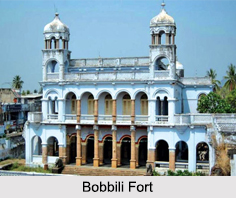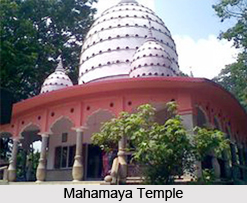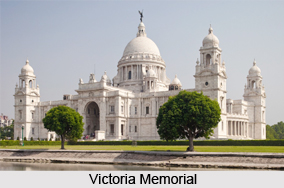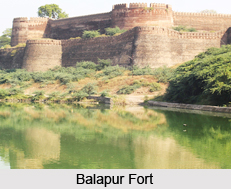 Located in the Vizianagaram district of the Indian state of Andhra Pradesh, the Bobbili Fort was built during the middle of the 19th century by Chinna Ranga Rao, who had survived the Battle of Bobbili and later became the ruler of Bobbili.
Located in the Vizianagaram district of the Indian state of Andhra Pradesh, the Bobbili Fort was built during the middle of the 19th century by Chinna Ranga Rao, who had survived the Battle of Bobbili and later became the ruler of Bobbili.
History of Bobbili Fort
With the arrival of Sher Muhammad Khan, Fouzdar of the Nawab of Srikakulam in the Vizianagaram district, the history of the Bobbili Fort can be traced back to 1652. After his arrival, he was accompanied by Peddarayadu, the 15th scion of the Rajas of Venkatgiri and the ancestor of the Rajas of Bobbili. As per the early records, there are several versions to the construction of the fort.
One of the legends states that the Nawab pleased with the gallant services of Peddarayadu had granted him with land holdings. And thus, Peddarayadu constructed the fort on this land and named it Bobbili, which means the royal tiger, as a token of appreciation for the benevolent gift of the Nawab. In another version it is said that Rayudu`s son Lingappa chose Bobbili as his capital, built a fort and established a town there, and named it Peddapuli, which was eventually changed to Bobbili.
In 1756, there was a rebellion among the local chieftains, on account of the rivalry between the chiefs of Bobbili and Vizianagaram. The then French General Charles Bussy attacked the rebel forces with a contingent of European forces, supported by 11,000 troops of the Raja of Vizianagaram as a token of his loyalty. The Raja of Vizianagaram had manipulated the General by instigating him and making him believe that the Raja of Bobbili was behind the rebellion. General Bussy attacked the fort several times, breached the mud fort with cannons, and took control of the ramparts of the fort. Although the Raja of Bobbili and his defenders realized their precarious condition, they fought fiercely till the very end but eventually lost the battle.
The surviving members of the Bobbili family were the Raja`s brother Vengal Ranga Rao, also called Chinna Ranga Rao, and his baby son. After their escape, in 1759, they were offered their old holdings under a compromise package and were given the Kavit and Rajam taluks and the fort area for an annuity lease value of Rs.20,000.
They ruled the land for few years but dispute broke out again and Chinna Ranga Rao was imprisoned by Sitaram, the new Raja of Vizianagaram. In 1790, he managed to escape imprisonment and after his death in 1801, efforts were made to merge Bobbili with Vizianagaram but these were thwarted and a lasting settlement of the property was made with the adopted son of Ranga Rao called Rayadappa.
Features of Bobbili Fort
Spreading over an area of almost 10 acres, the Bobbili Fort was built in the Indo- Saracenic architectural style. With high walls ranging to almost 20 ft in height, the facade of the fort has the elegance of a palace. The north eastern entry to the fort is a tall domed structure. The entire palace complex covers the area of 40,000 sq. ft. Included within the confines of the four walls of the fort are palaces, halls and temples. There is a Durbar Hall, where coronations were done way back. Currently, the main palace comprises of a museum. There are two temples within the fort: one is a family deity of Venugopala Swamy and was built at the time of founding of Bobbili; another one was erected by Chinna Ranga Rao in the aftermath of the war, after he regained his territory.
The Bobbili Fort is still visited by tourists and is a popular place of attraction.
Visiting Information on Bobbili Fort
The nearest railway station is at Vizianagaram at a distance of almost 58 km and the Vishakhapatnam Airport is the closest at about 112 km away from the fort. There is a bridge across the Vedavati River, which provides access to the area.




